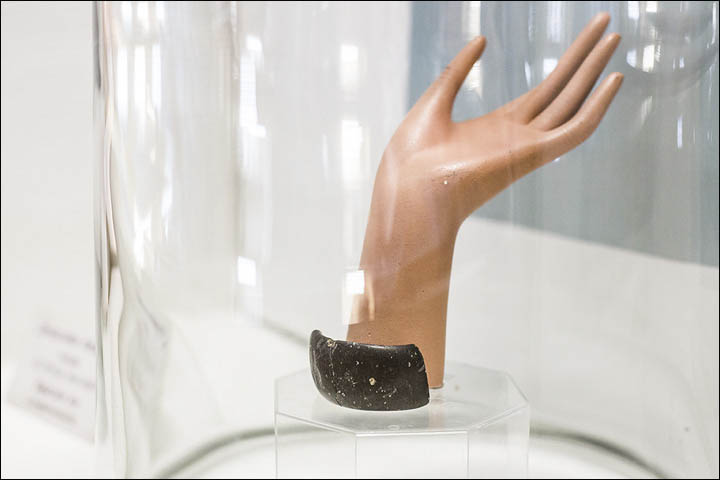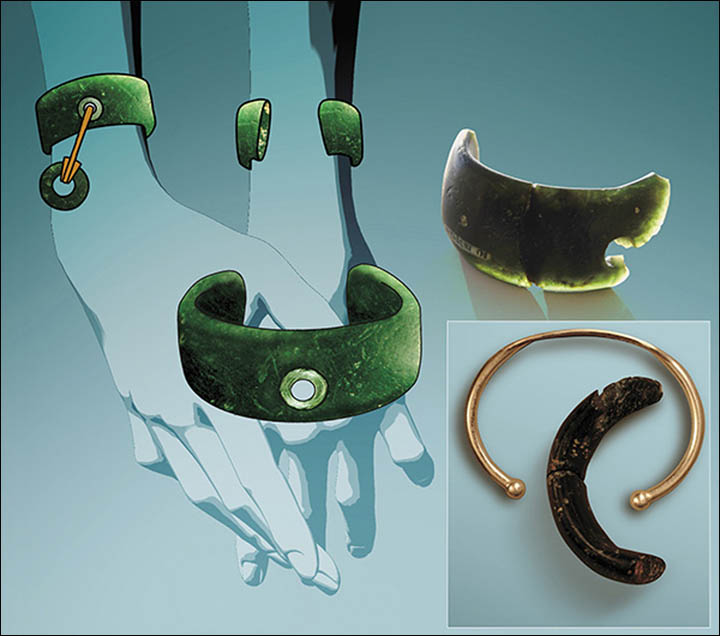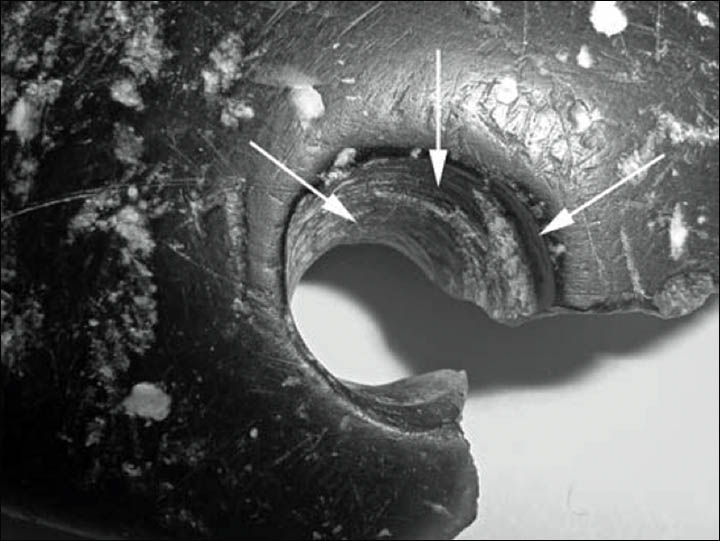BY: CHRISTOPHER WAI
Note: For readers with a biological anthropology background, I am aware of the technical error above. Unfortunately I couldn't properly italicize Homo sapiens in the title!
 |
| Denisovan bracelet, Museum of History and Culture of the Peoples of Siberia and the Far East in Novosibirsk. Photograph by Vera Salnitskaya |
2015 was a great year for evolutionary anthropology with the most exciting find being the potentially new member of our genus: Homo naledi. However, two other interesting news stories have also been added to the new questions we have in the new year.
Eagle talons that may have formed part of a necklace/pendant by Neandethals and a Denisovan stone bracelet.
 |
| Neanderthal made Eagle Talon necklace Pendant? Photograph by Luka Mjeda, Zagreb |
Eagle Talon Necklace- Homo Neanderthalensis
Found over a century ago in Krapina, Croatia in association with the Mousterian stone tool tradition of the Neanderthals, Davorka Radovčić, a curator of Geology and Paleontology at the Croatian Natural History Museum, theorized that they may have been part of a necklace or pendant.
The evidence?
Notches on the talons.
| Fig 7. Three examples of human manipulation |
Convinced?
The results of this research were published on March 11, 2015 by Radovčić, and his colleagues. It can be read in its entirety here.
Bigger Context: What we now know about Homo Neanderthalensis?
This possible example of Neanderthal ornamentation is not isolated.
This possible example of Neanderthal ornamentation is not isolated.
"Ornaments are commonly associated with fossil Homo sapiens and are thought to represent the special cognitive abilities and symbolic capacities of modern humans [1–4]. Studies in recent years have documented Neandertals using or producing art and symbolic items evidenced by unusual lithic objects [5], feathers [6–7], modified shells [8–9], ochre [10–13], mobiliary and cave art [14–17] and very sporadically raptor talons, consisting of single elements, presumably used as pendants [18].[...]
They are the earliest evidence for jewelry in the European fossil record and demonstrate that Neandertals possessed a symbolic culture long before more modern human forms arrived in Europe." - Davorka Radovčić et al. 2015Discussions on Neanderthal complexity have been a core part of present day research that has reevaluated much of the older misconceptions about the Neanderthals. Unfortunately, the persistent myth of them being vastly inferior, dumb or vicious comes from the misinterpretations and rhetoric from the 19th century and reinforcement into the 20th in pop culture.
 |
| Appears to be an image from one of the old Field Museum dioramas. Source. |
 |
| A more recent recent reconstruction of a Neanderthal woman and man. Neanderthal Museum, Mettmann, Germany. Source. |
Neanderthals preceded us and were still around by the time we arrived from Africa. We coexisted with them, but they died off relatively soon after. Perhaps it was because of the competition for resources with us, a changing environment, and to a lesser extent interbreeding (some populations appear to have anywhere from 1-4% neanderthal DNA, though there is still a longstanding debate). The Neanderthal genome has also been sequenced as of 2010 by the Max Planck Institute.
They were more robust, often had larger skulls than ours (sloped foreheads and larger brow ridges but not small heads!) could methodically craft stone tools, used spears to hunt and maintained fires.
There are also possibly multiple cases of them purposefully burying their dead.
 |
| Reconstruction of burial at La Chappelle-Aux-Saints. PHOTOGRAPH BY DEA, A. DAGLI ORTI/DE AGOSTINI Getty Images |
Denisovan Stone Bracelet
Who?
The Denisovians are a group that is less well known and understood, but research is ongoing! In fact, the exact taxonomy has yet to be settled on.
The expediently long and short of it though is that they may have co-existed and interbred with both humans and Neanderthals based on DNA evidence.
This chlorite bracelet originally found in 2008 adds another component to the puzzle though.
This chlorite bracelet originally found in 2008 adds another component to the puzzle though.
Researchers do not believe that it was contamination from a more recent context/ level, but if not, then all we have are questions.
 |
| Bracelet from Denisova Cave, Altai Region, Siberia. Anatoly Derevyanko and Mikhail Shunkov |
 |
| Reconstruction. Anatoly Derevyanko and Mikhail Shunkov, Vera Salnitskaya |
What makes this discovery perplexing is that the techniques and skills required to produce this artifact has never been known to have existed during this particular time.
 |
| Evidence of drilling. Anatoly Derevvanko and Mikhail Shunkov, Vera Salnitskava. |
It implies that the Denisovans had a well-developed a skill set that neither H. sapiens nor H. neanderthalensis had then.
Unfortunately, it is the only example thus far.
Perhaps more details will follow.
Conclusion of Questions
There are many questions to be asked about the complexity of our relatives and also how similarly or differently we saw the world.
What it means to be uniquely human and whether that existential question or crisis matters is almost always brought up. In our humanly quest to eternally redefine ourselves as special, we may separate ourselves too much. But at the same time, when we draw similarities, do we also draw false equivalences?
It's the old "splitters vs. lumpers" debate that occurs in anthropology when it comes to creating categories.
What are the Neanderthals and Denisovans to us? How different were they?
These pieces are also unique in that they
have survived in the material record and there are few other examples
to look at, so how much can we read into them?
When it comes to the objects above, shall we call them "jewellery", decoration, personal, ritual adornment, and all the implications (i.e. economic, cultural, ethnic, social, gender-based constructs associations) that come with them?
Where shall we stand I wonder, when it
comes to making sense of this?
 |
| Reconstruction of a Neandertal girl. Rekonstruktion eines Neandertalermädchens. © Johannes Krause, Neandertal group by Atelier Daynes, Paris, France. In: Museum of the Krapina Neanderthals, Krapina, Croatia. Project and realization of the Museum: Zeljko Kovacic and Jakov Radovcic. |



No comments:
Post a Comment
Note: only a member of this blog may post a comment.